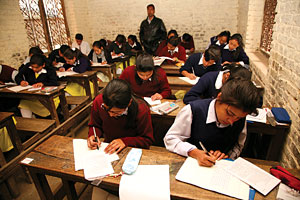 MIN RATNA BAJRACHARYA |
Some of them will be declared 'failed', others will pass, a few with flying colours. Once more, the results will illustrate the gross inequality in Nepal's education system. And what will these young people do once they are out of school?
In these uncertain times, the general attitude ('we'll cross that bridge when we come to it') has its advantages. But the decision becomes a little complicated when rivers are deep and the choice involves building a bridge, waiting at the edge while you wait for someone to throw the rope, or just jumping off the cliff and hoping for the best. No wonder students appear so stressed.
The last choice is the only one available to students stigmatised by society as failures, usually for no fault of their own. In a majority of public schools in rural areas, untrained and unmotivated teachers struggle with syllabuses that have no relationship with the ground reality.
Other than the 3Rs of reading, writing and arithmetic, school education in rural Nepal teach no life skills. Students don't learn about farming, how to make a plough, produce manure, keep goats, build huts, grow trees, look after the elderly, attend to the sick, clean streets, dig wells, play dhime baja or organise village communes. The best that they can wish is a chance to take up the gun for others, like the British or Indian Army, if they are lucky. Or to migrate for work.
There are private schools in urban areas that teach to build bridges, but most churn out youths with exaggerated sense of self-importance. For them, this country is beyond redemption. Their talent needs a more conducive environment, so they troop off to educational consultancies for student visas to Australia, Belgium, Cyprus, Denmark. Anywhere, as long as they can escape the country that they think has no future.
But even for an education system designed by default for the mass production of mediocrity, it's possible to save seeds for the future of the country. Unfortunately, the post-school facilities of training the willing are in equally bad shape, if not worse. For those who are fortunate enough to be declared 'passed', technical schools are few, mostly of a standard that leaves a lot to be desired.
The intermediate level education of Tribhuban University and majority of +2 teaching shops are merely places for the ambitious where they playact while they wait to be served with appropriate opportunity: an admission into professional colleges, a scholarship abroad, a job through connections or a career in politics. Very few have the confidence left to begin a trade or join an occupation by the time they finish secondary education.
The main problem with Nepal's school system is that it churns out individuals who wish to consume but have little ability to produce. Even among the relatively privileged, some become cheerful robots of the NGO-industry. Many end up as no-collar automatons at projects and aid agencies. Nepali economy is in doldrums. The tragedy is that our youthful workforce lacks the will?and tools?to pull it out of this rut.
In the Birth Centenary year of social thinker Ram Manohar Lohia, it may be appropriate to learn from the model he envisioned for his own country. Like India of Lohia's time, Nepal is a capital-scarce but labour-abundant country. Our problems are compounded by the fact that generations of Nepalis have availed of the easy option of withdrawing from the national economy by becoming Lahures. Had remmitances been the best way to build a country, Nepal would already be Switzerland of Asia and the Philippines would be Japan. The hard reality is that there is no alternative to building a prosperous economy but pulling ourselves up by our bootstraps.



